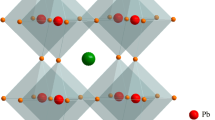Abstract
Perovskite solar cells single-doped with Br− or Cs+ ions have been proved to be an effective approach to improve their efficiency and stability. In our work, we took advantage of co-doping with Br− and Cs+. At our studied doping levels from CH3NH3I:PbI2:CsBr = 1:1:0 (x = 0) to 0.85:1:0.15 (x = 0.15), CsBr doping does not introduce any detectable impurity, and the crystal grains grow larger with increasing CsBr doping level. Furthermore, when the CsBr doping level is less than x = 0.1, it can progressively enhance the optical absorption of the perovskite film, although the absorption begins to decrease when the doping level rises above x = 0.1. X-ray photoelectron spectroscopy measurements show that Br− has successfully replaced I− and bonds with Pb2+ after CsBr doping. At the optimized doping level of x = 0.1, the incorporation of CsBr in the reaction system can improve the morphology of perovskite films and greatly enhance the efficiency from 9.8% for undoped sample to 13.6%, better than single Br− or Cs+ doping. Our result shows that CsBr doping is an effective method to enhance the efficiency of perovskite solar cells.




Similar content being viewed by others
References
Kim YH, Cho H, Heo JH et al (2015) Multicolored organic/inorganic hybrid perovskite light-emitting diodes. Adv Mater 27:1248–1254
Lee MM, Teuscher J, Miyasaka T et al (2012) Efficient hybrid solar cells based on meso-superstructured organometal halide perovskites. Science 338:643–647
Stranks SD, Eperon GE, Grancini G et al (2013) Electron-hole diffusion lengths exceeding 1 micrometer in an organometal trihalide perovskite absorber. Science 342:341–344
Xing G, Mathews N, Sun S et al (2013) Long-range balanced electron- and hole-transport lengths in organic-inorganic CH3NH3PbI3. Science 342:344–347
Saliba M, Matsui T, Seo JY et al (2016) Cesium-containing triple cation perovskite solar cells: improved stability, reproducibility and high efficiency. Energy Environ Sci 9:1989–1997
Hao F, Stoumpos CC, Cao DH et al (2014) Lead-free solid-state organic-inorganic halide perovskite solar cells. Nat Photon 8:489–494
Hendon CH, Yang RX, Burton LA et al (2014) Assessment of polyanion (BF4− and PF6−) substitutions in hybrid halide perovskites. J Mater Chem A 3:9067–9070
Kim HS, Lee CR, Im JH et al (2012) Lead iodide perovskite sensitized all-solid-state submicron thin film mesoscopic solar cell with efficiency exceeding 9%. Sci Rep 2:591
Liu M, Johnston MB, Snaith HJ (2013) Efficient planar heterojunction perovskite solar cells by vapour deposition. Nature 501:395–398
Xiao Z, Bi C, Shao Y et al (2014) Efficient, high yield perovskite photovoltaic devices grown by interdiffusion of solution-processed precursor stacking layers. Energy Environ Sci 7:2619–2623
Barrows AT, Pearson AJ, Kwak CK et al (2014) Efficient planar heterojunction mixed-halide perovskite solar cells deposited via spray-deposition. Energy Environ Sci 7:2944–2950
Chen Y, Zhao Y, Liang Z (2015) Non-thermal annealing fabrication of efficient planar perovskite solar cells with inclusion of NH4Cl. Chem Mater 27:1448–1451
Zuo CT, Ding LM (2014) An 80.11% FF record achieved for perovskite solar cells by using the NH4Cl additive. Nanoscale 6:9935–9938
Choi H, Jeong J, Kim HB et al (2014) Cesium-doped methylammonium lead iodide perovskite light absorber for hybrid solar cells. Nano Energy 7:80–85
Saliba M, Matsui T, Seo JY et al (2016) Cesium-containing triple cation perovskite solar cells: improved stability, reproducibility and high efficiency. Energy Environ Sci 9:1989–1997
Noh JH, Sang HI, Jin HH et al (2013) Chemical management for colorful, efficient, and stable inorganic-organic hybrid nanostructured solar cells. Nano Lett 13:1764–1769
Suarez B, Gonzalez-Pedro V, Ripolles TS et al (2014) Recombination study of combined halides (Cl, Br, I) perovskite solar cells. J Phys Chem Lett 5:1628–1635
Tang S, Deng Y, Zheng X et al (2017) Composition engineering in doctor-blading of perovskite solar cells. Adv Energy Mater 7:1700302-1–1700302-7
Qiu W, Ray A, Jaysankar M et al (2017) An interdiffusion method for highly performing cesium/formamidinium double cation perovskites. Adv Funct Mater 27:1700920-1–1700920-9
Yuan SS, Zhang Y, Liu WQ et al (2014) Efficient inverted organic solar cells using Zn-doped titanium oxide films as electron transport layers. Electrochim Acta 116:442–446
Ahn N, Son DY, Jang IH et al (2015) Highly reproducible perovskite solar cells with average efficiency of 18.3% and best efficiency of 19.7% fabricated via Lewis base adduct of lead(II) iodide. J Am Chem Soc 137:8696–8699
Burschka J, Pellet N, Moon SJ et al (2013) Sequential deposition as a route to high-performance perovskite-sensitized solar cells. Nature 499:316–319
Zhu W, Bao C, Li F et al (2016) A halide exchange engineering for CH3NH3PbI3−x Br x perovskite solar cells with high performance and stability. Nano Energy 19:17–26
Zhao YX, Zhu K (2013) Charge transport and recombination in perovskite (CH3NH3)PbI3 sensitized TiO2 solar cells. J Phys Chem Lett 4:2880–2884
Niemann RG, Gouda L, Hu J et al (2016) Cs+ incorporation into CH3NH3PbI3 perovskite: substitution limit and stability enhancement. J Mater Chem A 4:17819–17827
NIST X-ray photoelectron spectroscopy database. https://srdata.nist.gov/xps/. Accessed Apr 2017
Tu Y, Wu J, Lan Z et al (2017) Modulated CH3NH3PbI3−x Br x film for efficient perovskite solar cells exceeding 18%. Sci Rep 7:44603-1–44603-8
Atourki L, Vega E, Marí B et al (2016) Role of the chemical substitution on the structural and luminescence properties of the mixed halide perovskite thin MAPbI3−x Br x (0 ≤ x ≤ 1). Appl Surf Sci 371:112–117
Acknowledgements
This research was sponsored by the National Natural Science of China (Nos. 11674083, 51571083, 11305046).
Author information
Authors and Affiliations
Corresponding authors
Ethics declarations
Conflicts of interest
The authors declare that they have no conflict of interest.
Electronic supplementary material
Below is the link to the electronic supplementary material.
Rights and permissions
About this article
Cite this article
Zhang, LY., Zhang, Y., Guan, WB. et al. Large enhanced conversion efficiency of perovskite solar cells by CsBr doping. J Mater Sci 52, 13203–13211 (2017). https://doi.org/10.1007/s10853-017-1429-3
Received:
Accepted:
Published:
Issue Date:
DOI: https://doi.org/10.1007/s10853-017-1429-3




